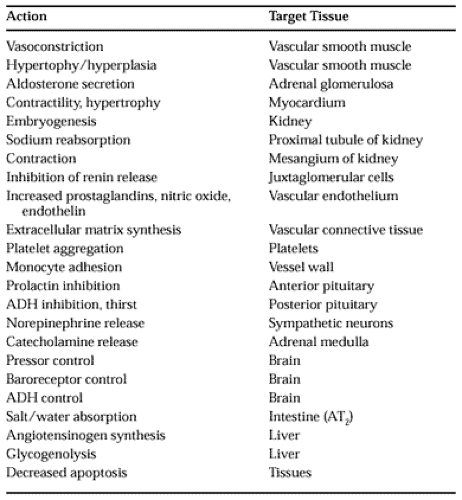ACTIONS OF ANGIOTENSIN II
Renal Sodium and Water Retention.
The best known function of A-II is to support the circulation under conditions of reduced intravascular volume. However, there are >50 known physiologic actions. These include vasoconstriction, salt retention through aldosterone, increased thirst and secretion of antidiuretic hormone resulting in retention of water, increased cardiac output, and stimulation of sympathetic nervous system activity (Table 79-3). Also, there are direct effects of A-II on early proximal tubule Na+ reabsorption that are mediated in part through the Na+, H+ antiporter; this accounts for 40% to 50% of sodium and water reabsorption.58 In AGT gene-null mutant mice, chronic volume depletion causes a sharp decrease in glomerular filtration rate (GFR) and a marked concentration defect, which is insensitive to AVP.59 Furthermore, the renin-angiotensin system is essential for two fundamental homeostatic functions in the kidney, stabilizing the GFR and maintaining urine diluting and concentrating capacity.
Systemic Vasoconstriction.
A-II produces arteriolar vaso-constriction and elevates vascular resistance and blood pressure. The signal transduction for this A-II–mediated vasoconstriction includes an increase of intracellular calcium and formation of protein kinase C.60 The facilitated release of norepinephrine61 and endothelin-I62 may also contribute to the vasoconstriction that is induced by A-II. A-II stimulates the release of arachidonic acidproducts in the vasculature (e.g., lipoxygenase products and P450 epoxides), which have vasoconstrictive properties.63
Regulation of Gomerular Filtration Rate.
A-II regulates the GFR and renal blood flow by constricting the efferent and afferent glomerular arterioles, and the interlobular artery.64 A-II differentially increases efferent resistance to levels that are two to three times those of the afferent resistance; this elevates glomerular capillary pressure to maintain the single nephron GFR.
Stay updated, free articles. Join our Telegram channel

Full access? Get Clinical Tree






